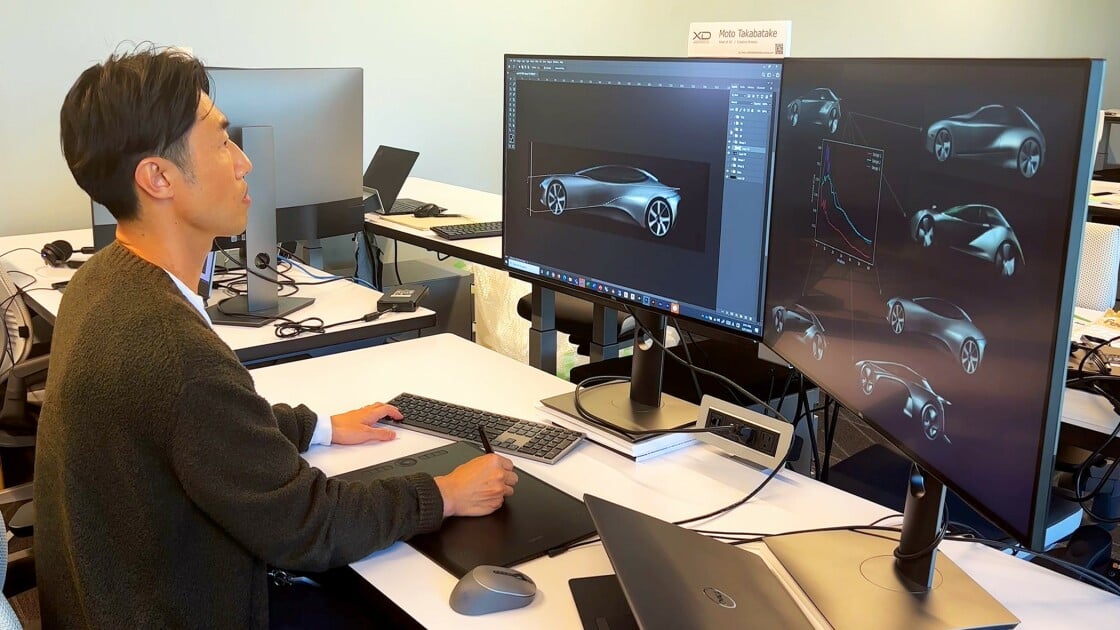
A Toyota designer uses the new generative AI tool. (Credit: Toyota)
A new generative AI tool (Opens in a new window) is helping designers in the Toyota Research Institute (TRI) get a head start on creating new vehicles.
It’s a text-to-image tool: This means employees can prompt it with words like “sleek,” “SUV-like,” and “modern,” and the tool produces an “initial prototype sketch” to match the description, Toyota says.
The goal is to help with the early steps of the creative process and to cut down the iterations needed to get to the final design.
“Generative AI tools are often used as inspiration for designers but cannot handle the complex engineering and safety considerations that go into actual car design,” says Avinash Balachandran, director of TRI’s Human Interactive Driving (HID) Division in the company’s announcement. “This technique combines Toyota’s traditional engineering strengths with the state-of-the-art capabilities of modern generative AI.”
The tool considers engineering constraints in the design as well, such as the amount of drag and size of the cabin. This can help optimize aerodynamics, which heavily affects fuel efficiency—especially for electric vehicles.
“Reducing drag is critical for improving the aerodynamics of BEVs to maximize their range,” says Takero Kato, BEV factory president at Toyota Motor Corporation.

Currently, Toyota offers just one electric vehicle, the bz4x. Its range is between 222 and 252 miles depending on trim, which is in the average to lower end of the market. Lexus, the luxury arm of Toyota, makes the RZ, which has a range of196 to 220 miles.
Toyota is pivoting to fully electrifying its lineups and has positioned Lexus as its flagship EV brand in the coming years. The generative AI tool “could help Toyota design electrified vehicles more quickly and efficiently,” Toyota says.
Other automakers are also turning to AI to help design EVs. Kia senior designer Mark Rumsey gave PCMag a tour of its virtual-reality design system at the reveal of the 2024 EV9 SUV at the New York Auto Show in April.
@electric_humans (Opens in a new window) At the Kia EV9 reveal in New York City, Kia senior designer Mark Rumsey shows us how the California- and Korea-based teams use VR to collaborate on design tweaks before bringing it to life in a full model. Here he is with the Meta Quest 2 VR goggles and Kia design software. #electricvehicle (Opens in a new window) #vr (Opens in a new window) #metaquest2 (Opens in a new window) #kia (Opens in a new window) #ev9 (Opens in a new window) #nyias (Opens in a new window) ♬ original sound – Emily Dreibelbis (Opens in a new window)
Unlike Toyota’s new tool, Kia’s system is not a text-to-image generator. Instead, designers don a VR headset to meet coworkers around the world in a digital design studio. Toyota’s tool builds more on the techniques used by AI tools including Midjourney and DALL-E , which allow a user to describe their desired image with a few words to speed up the design process.
Get Our Best Stories!
Sign up for What’s New Now to get our top stories delivered to your inbox every morning.
This newsletter may contain advertising, deals, or affiliate links. Subscribing to a newsletter indicates your consent to our Terms of Use and Privacy Policy . You may unsubscribe from the newsletters at any time.




